�
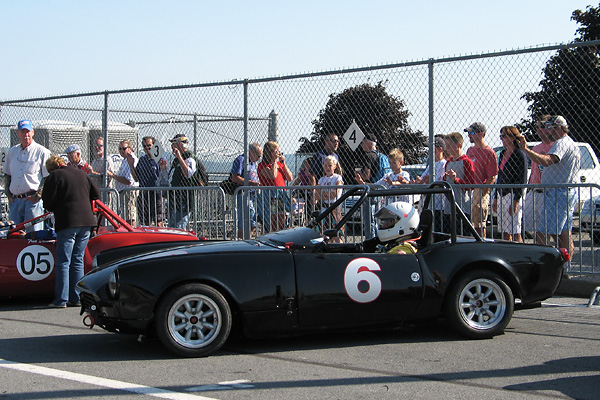
�
Pat Ryan's 1967 Triumph Spitfire Racecar
� � Owner: Pat Ryan� City: Asheville NC and Montgomery AL
� Model: 1967 Triumph Spitfire
� Engine: 1296cc
� Race prepared by: Sam White and Rick Parent�
�
Background
��
Don Devendorf originally built this Spitfire, and he drove it to G-Production victory in the �
1968 SCCA Runoffs (held at Riverside). Devendorf was the odds-on favorite to win SCCA's 1969 �
G-Production Championship too, but although he qualified fastest (this time the Runoffs were held �
at Daytona), he had mechanical problems and had to withdraw before the start of the final race. �
In 1970, Devendorf won SCCA's E-Production Championship (held at Road Atlanta) in a Triumph GT6.�
�
At the 2009 U.S. Vintage Grand Prix, held at Watkins Glen, Pat Ryan drove this Spitfire to victory �
in the Group One feature race. His fastest lap was 2:20.683, at an average speed of 86.99mph. �
His overall average speed for the six lap race was 84.55mph. His margin of victory was�
0:19.448. The second place finisher was John McCue in an �
MG Midget. �
Mini Marcos driver Bob Polak�
was awarded the Optima Battery Award for sportsmanship. �
�
We asked Pat if he would fill us in on the Spitfire's various modifications. He just cited the �
custom exhaust header and the Krantz transmission, and then wrote "Everything else is period stock."�
We'll accept that as dry humor. The following specification list is based on our own observations.�
�
 �
�
�
�
Features and Specifications
�| Engine: | �nominally 1296cc Triumph four cylinder engine. �
(Stock dimensions would be 2.90" bore by 2.99" stoke, but class rules allow a 0.047" overbore.�
Internal engine parts are otherwise unregulated, including specifically roller rockers.)�
Dual 1.25" SU carburetors on custom fabricated tubular steel intake manifolds.�
MSD Pro Power HVC (high voltage / current) ignition coil.�
Breakerless ignition module. �
Taylor Spiro Pro 8mm silicone insulated spark plug wires.�
Fram HP1 oil filter, remotely mounted. | �
| Cooling: | �custom aluminum crossflow radiator with integral oil-to-water heat exchanger.�
Moroso coolant header tank. | �
| Exhaust: | �custom step-up headers. | �
| Transmission: | �Ron Krantz modified Triumph four speed transmission. | �
| Rear End: | �3.27:1 rear axle ratio. Summers Brothers Racing axles. | �
| Front Susp.: | �Carrera coil-over shock absorbers.�
Oversized tubular anti-sway bar, mounted on aluminum pillow blocks.�
Steering rack reinstalled on aluminum pillow blocks. | �
| Rear Susp.: | �Carrera "Hypershock" gas charged 2" diameter steel tube telescoping shock absorbers.�
Z-bar to reduce swing-axle jacking effect, mounted on aluminum pillow blocks.�
Adjustable trailing links. | �
| Brakes: | �(master) dual Girling master cylinders with adjustable bias bar. � (front) stock Triumph Spitfire calipers and 9" rotors. � (rear) stock Triumph Spitfire 7" drums. | �
| Wheels/Tires: | �Panasport Racing 13x6 aluminum wheels with Hoosier Street T.D. (185/60D13) tires. | �
| Electrical: | �Nippondenso alternator with CV Products oversize pulley.�
Gear reduction starter. | �
| Instruments: | �(left to right)�
AutoMeter ProComp tachometer (0-9000rpm, plus shift light),�
Daytona Sensors WEGO-II digital air/fuel ratio display,�
Stewart Warner oil pressure (5-100psi),�
Stewart Warner water temp (100-265F),�
Stewart Warner oil temp (140-325F),�
Stewart Warner fuel pressure (0-15psi). | �
| Fuel System: | �Holley fuel pressure regulator. | �
| Safety Eqpmt: | �Kirkey aluminum racing seat.�
Simpson 5-point cam-lok safety harness.�
Quick release steering wheel hub, on a Personal steering wheel.�
SPA Design AFFF (Aqueous Film Forming Foam) centralized fire suppression system. | �
| Weight: | �1452# mininum, per SVRA class rules. | �
| Racing Class: | �originally SCCA G-Production. Currently SVRA 1FP. | �
Engine Installation
��

�
Nominally 1296cc Triumph four cylinder engine.
�
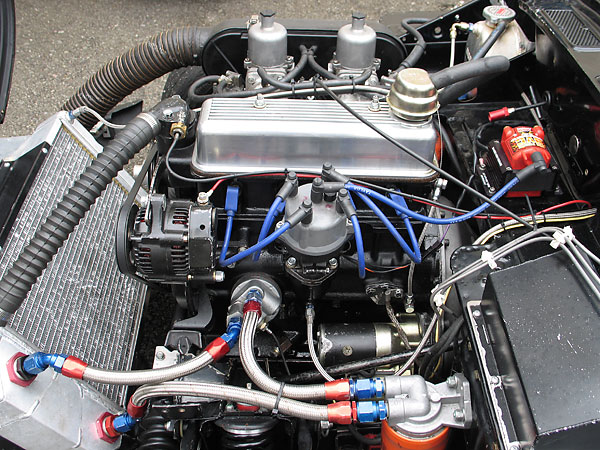
�
Everything in this picture is "period stock".
�
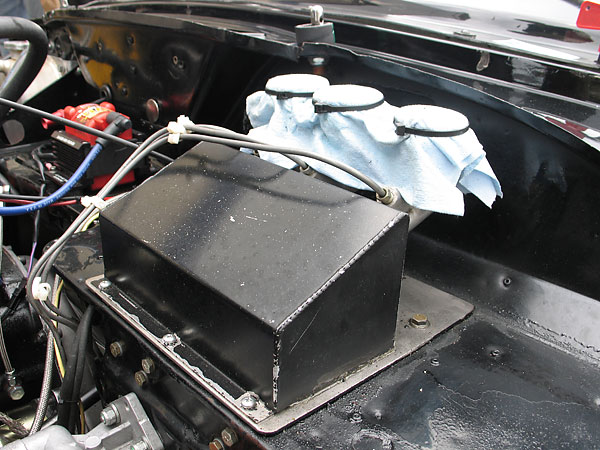
�
Dual Girling brake master cylinders with adjustable bias bar. Girling clutch master cylinder.
�
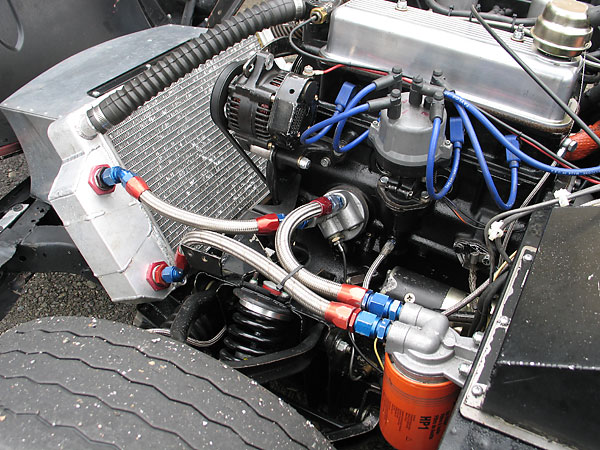
�
Custom aluminum radiator with integral oil-to-water heat exchanger.
�

�
Fram HP1 oil filter, remotely mounted.
�

�
Lucas distributor, updated with breakerless ignition module. (Notice that two leads enter at lower right.)
�
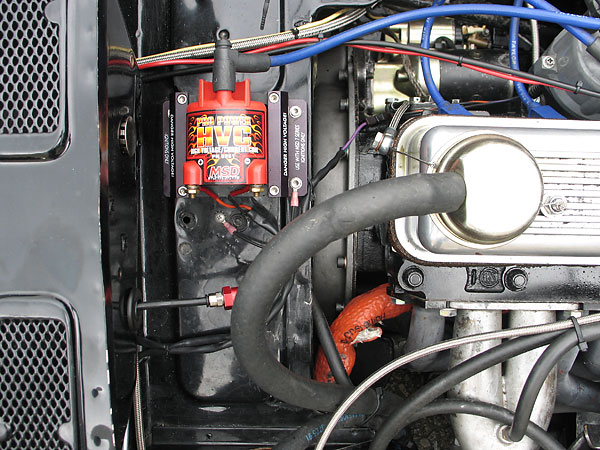
�
MSD Pro Power HVC (high voltage / current) ignition coil, model 8251.
�

�
Nippondenso alternator with CV Products oversize pulley.
�
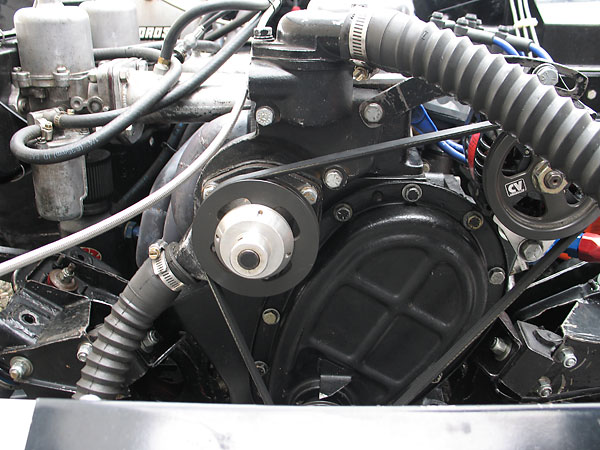
�
Water pump pulley.
�

�
Steering rack reinstalled on aluminum pillow blocks (instead of on rubber mounts, as original.)
�

�
Aluminum ductwork keeps airflow from bypassing the radiator core.
�

�
SVRA class rules limit carburetor options. For a 1.3L Spitfire, dual 1.25" S.U. carburetors are specified.
�
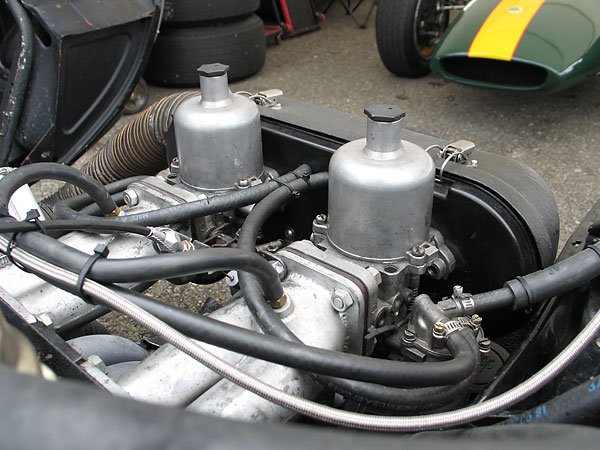
�
Custom fabricated tubular steel intake manifolds.
�
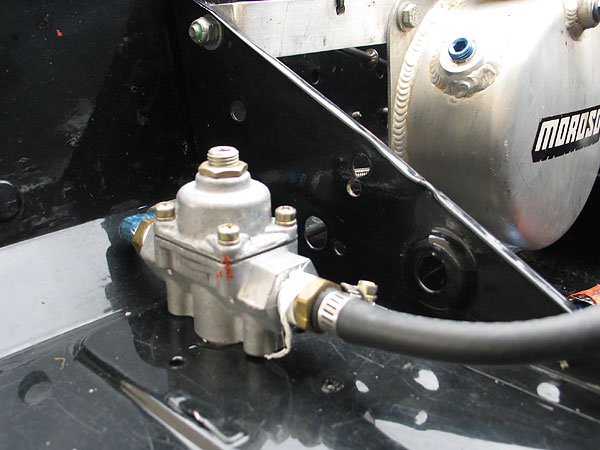
�
Holley fuel pressure regulator.
�

�
Moroso aluminum coolant header tank.
�
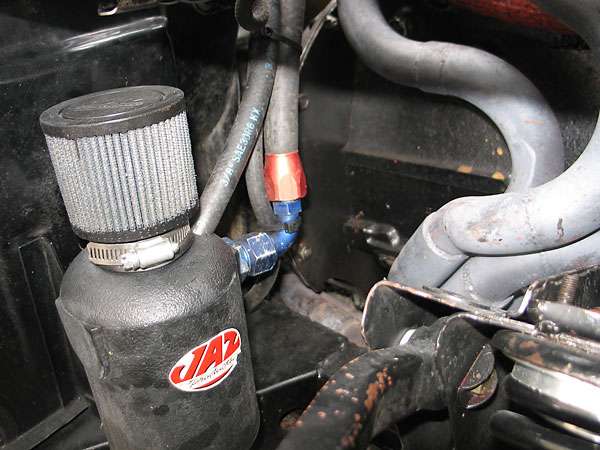
�
Jaz Products one quart overflow catch tank with crankcase breather.
�
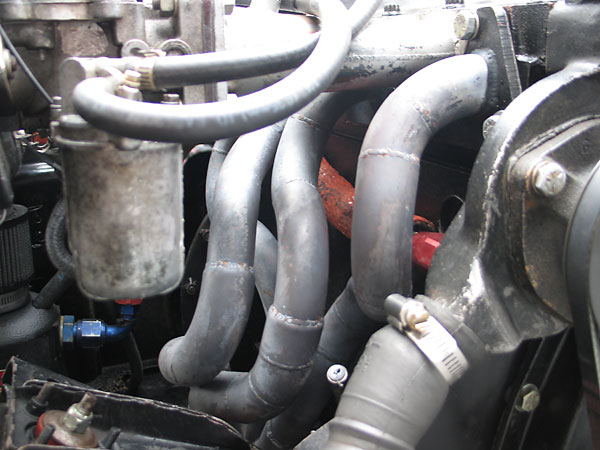
�
Hand-made custom headers, which increase in diameter (i.e. "step up") for improved performance.
�
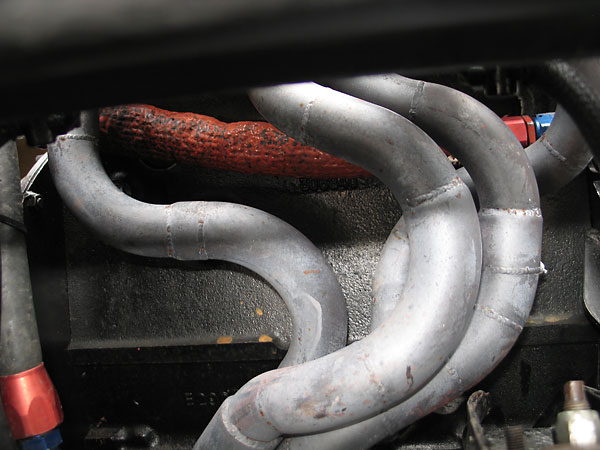
�
Another view of the custom exhaust headers.
�
�
Enjoying this article? www.BritishRaceCar.com is partially funded through generous support from readers like you!
�
To contribute to our operating budget, please click here and follow the instructions.
�
(Suggested contribution is twenty bucks per year. Feel free to give more!)�
Front Suspension
��
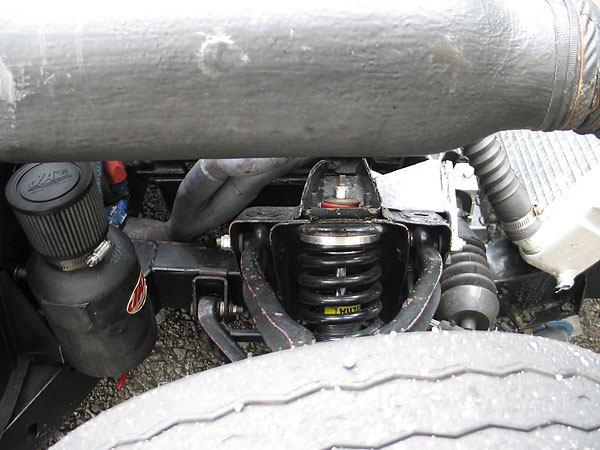
�
Carrera coil-over shock absorber.
�
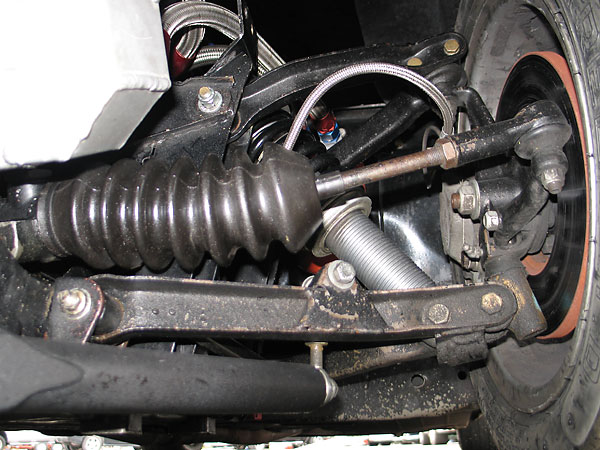
�
Class rules require stock Triumph Spitfire brake calipers and 9" rotors.
�
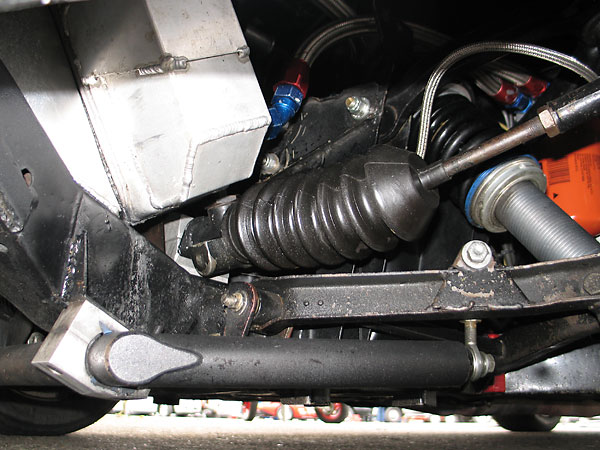
�
Oversized tubular anti-sway bar, mounted on aluminum pillow blocks.
�

�
Coil-over shocks make it easy to set ride height. Once the car is lowered, it's necessary to check
�
and usually to correct bump steer (i.e. the tendency for the front wheels to toe-in or out on bumps.)
�
�
Rear Suspension
��

�
Carrera Hypershock shocks are gas charged. They're mounted "upside down" to reduce unsprung weight.
�
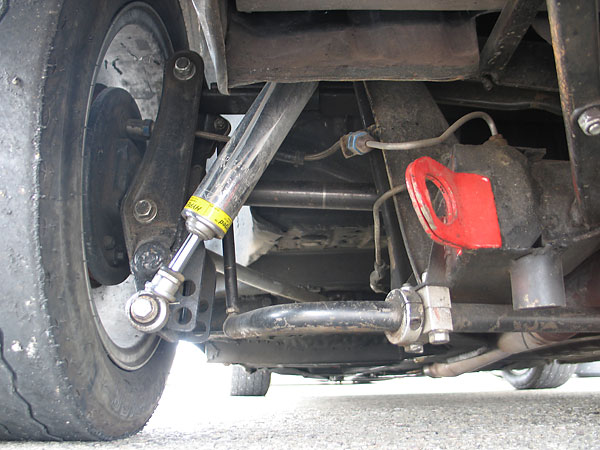
�
Incidentally, that's NOT an anti-sway bar mounted underneath the rear suspension. Notice that in plan
�
view it's Z-shaped instead of C-shaped. Swing axle rear suspensions as used on Spitfires, Corvairs,
�
many older Volkswagens can have a nasty habit of "jacking" and they tend to exhibit oversteer.
�

�
Unlike either suspension springs or anti-roll bars, Z-bars have no effect on roll stiffness! However, they
�
do increase the vertical stiffness of the rear suspension and reduce the swing-axle jacking effect.
�
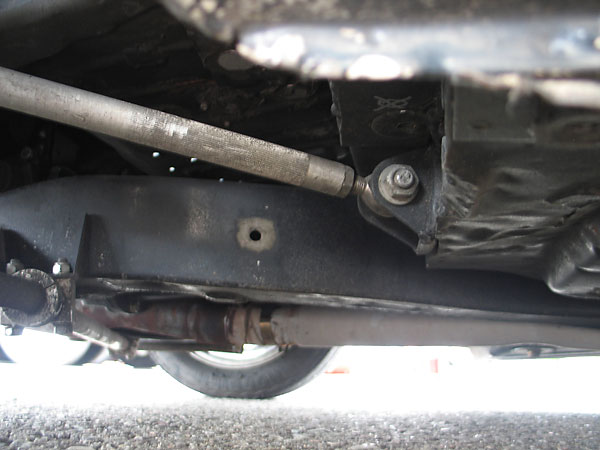
�
Adjustable trailing links.
�
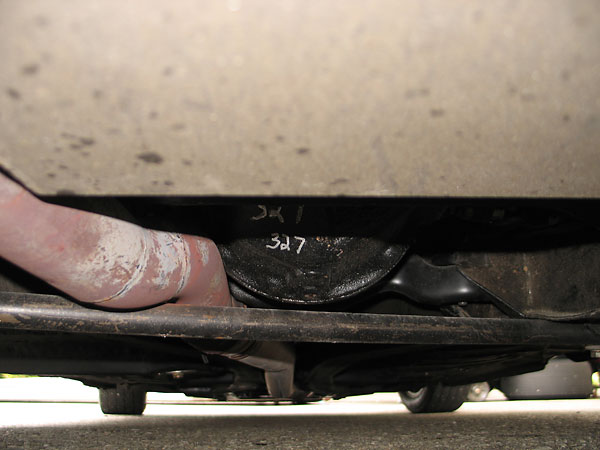
�
3.27: 1 gear ratio?
�
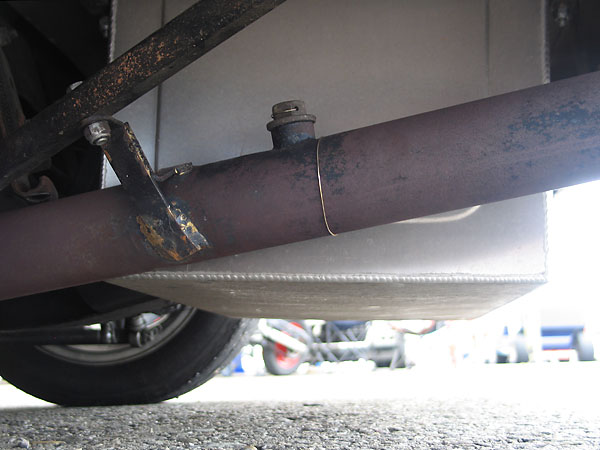
�
A bung in the tailpipe... and a view of the fuel cell box.
�
�
Interior
��

�
Engine turned aluminum dashboard.
�
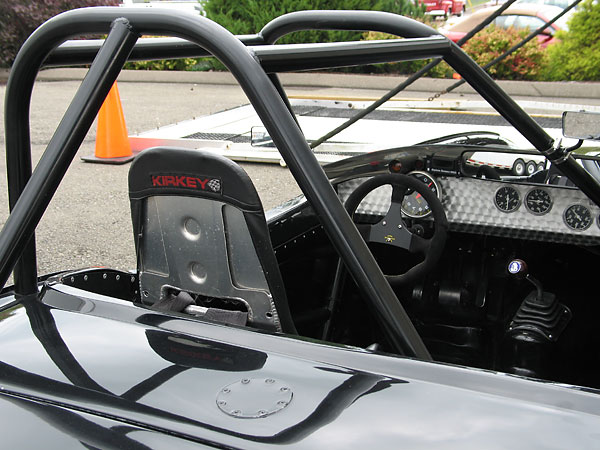
�
A Daytona Sensors WEGO-II digital air/fuel ratio display is mounted just above the tachometer.
�

�
Molded low-profile plastic windscreen in lieu of the original windshield.
�

�
Kirkey aluminum racing seat.
�
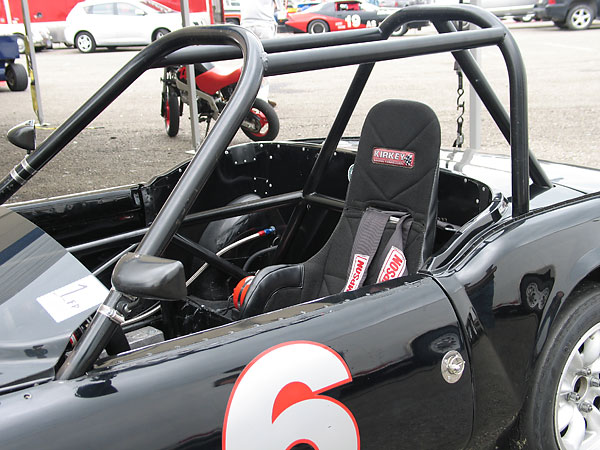
�
It's an interesting rollcage. Note also how a "hood pin" is used to secure the door.
�
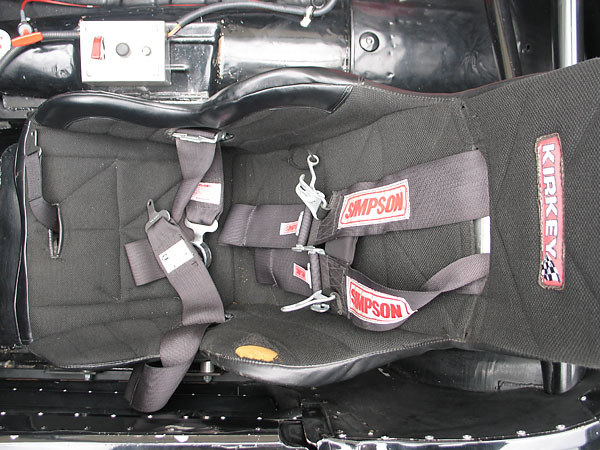
�
Simpson 5-point cam-lok safety harness.
�
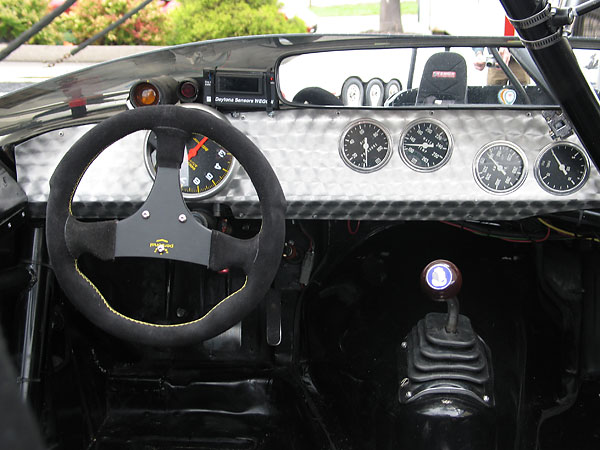
�
Personal suede covered ergonomic steering wheel, mounted on a quick release hub.
�

�
Stewart Warner oil pressure (5-100psi), water temp (100-265F), oil temp (140-325F),
and fuel pressure (0-15psi) gauges.
�
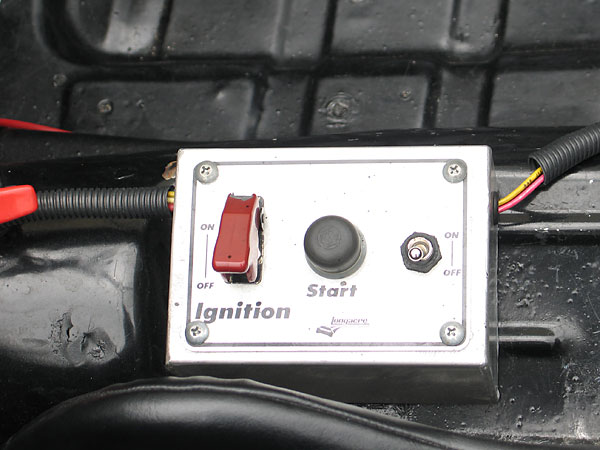
�
Longacre remote ignition and starter switch box.
�
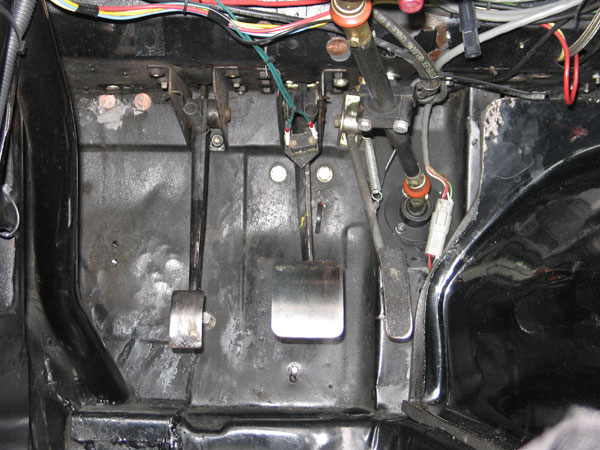
�
Pedal box. (This style of universal joint is more commonly used for shifter linkages.)
�
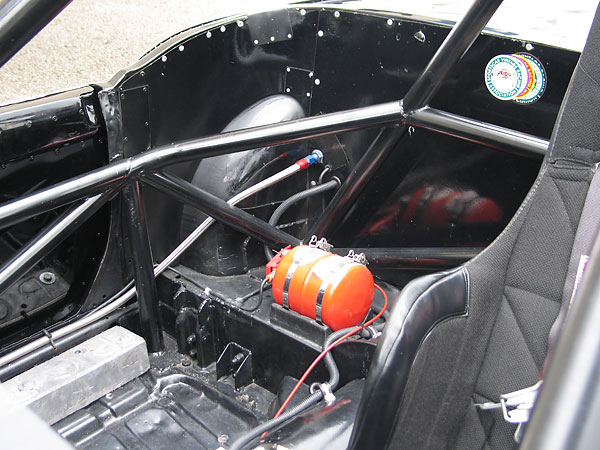
�
SPA Design AFFF (Aqueous Film Forming Foam) centralized fire suppression system.
�
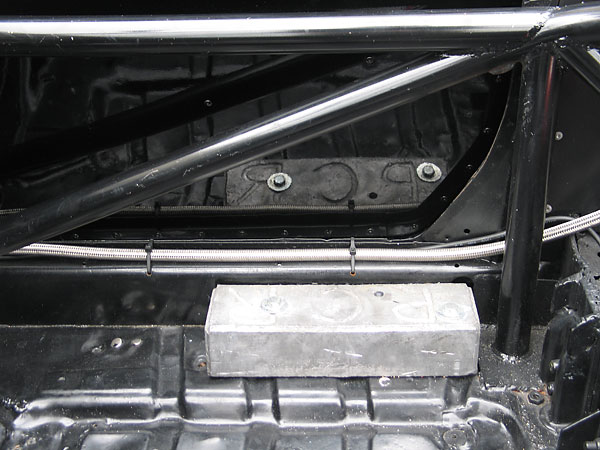
�
This brick of lead ballast probably weighs fifty pounds. It was evidently required to bring Pat's Spitfire
�
up to the minimum weight requirement for Spitfire's in their racing class, which is 1432 pounds plus
�
an additional twenty pounds for any racer who chooses to omit their passenger seat.
�
�
Exterior
��

�
Notice the characteristic camber of the Spitfire's rear wheels.
�
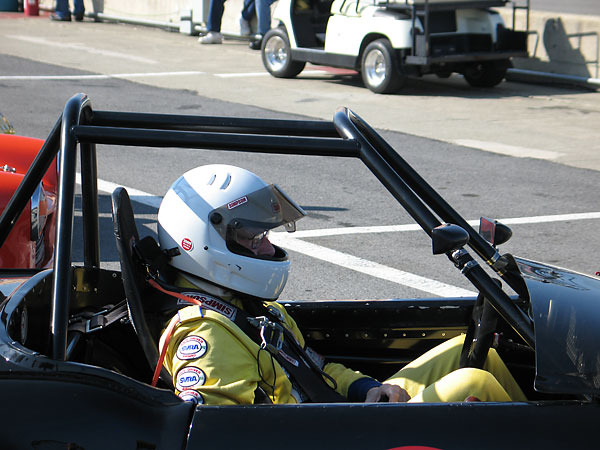
�
Pat Ryan awaits the start of the Group One race of the U.S. Vintage Grand Prix of Watkins Glen.
�
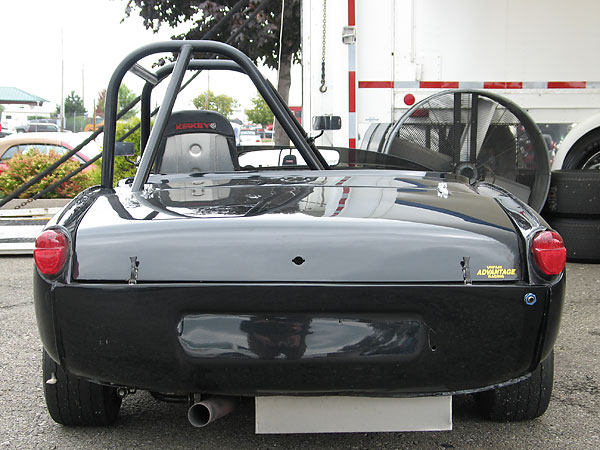
�
The yellow decal says "Unfair Advantage Racing". (Pat also races an ex-Donohue Chevy Camaro.)
�
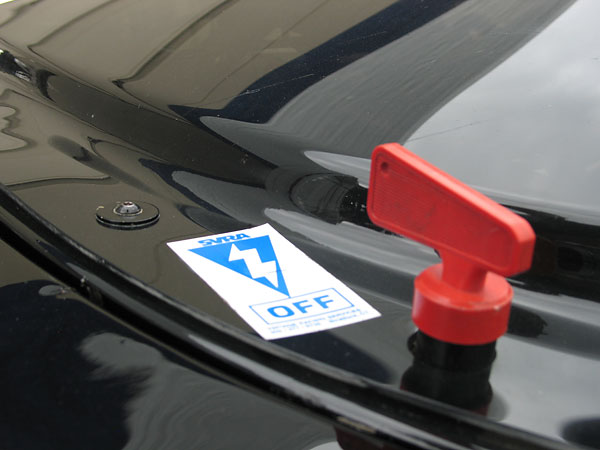
�
This emergency kill switch disconnects the battery and also grounds the alternator.
�
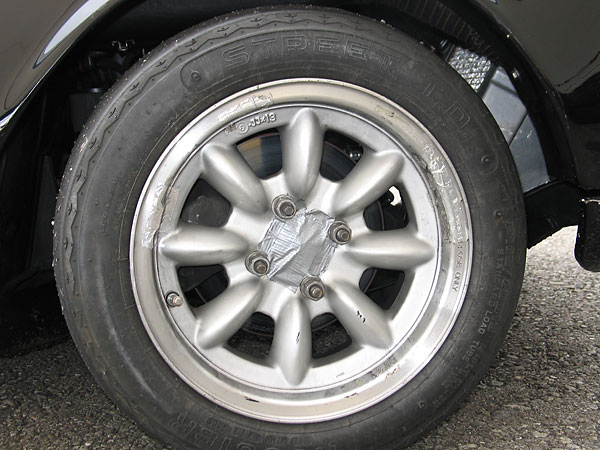
�
Panasport Racing 13x6 aluminum wheels.
�

�
Hoosier Street T.D. 185/60D13 tires. (Note the Summers Brothers Racing decal on the hub.)
�
�
All photos shown here are from September 2009 when we viewed the car at The US Vintage Grand �
Prix at Watkins Glen. All photos by Curtis Jacobson and Don Moyer for BritishRaceCar.com, copyright 2010. �
All rights reserved.
�
| If you liked this article, you'll probably also enjoy these: | �|||||
 | �
Harry Gentry '62 MG Midget | �
 | �
Richard Brown '64 Triumph Spitfire | �
 | �
Scott Janzen '68 Triumph GT6 | �
| You're invited to discuss anything you've seen here on The British Racecar Motorsports Forum! | �|||||
�
Notice: all the articles and almost all the photos on BritishRacecar.com are by Curtis Jacobson.
�
(Photos that aren't by Curtis are explicitly credited.) Reproduction without prior written permission is prohibited.
�
Contact us to purchase images or reproduction permission. Higher resolution images are optionally available.
�

 �
�